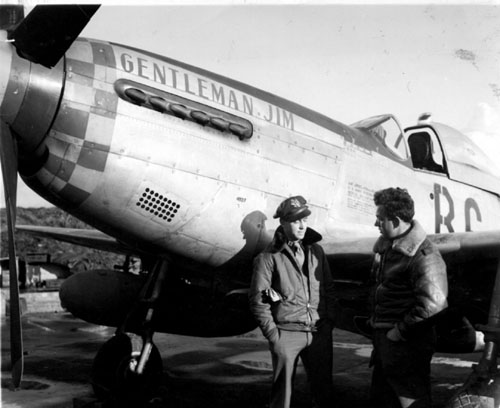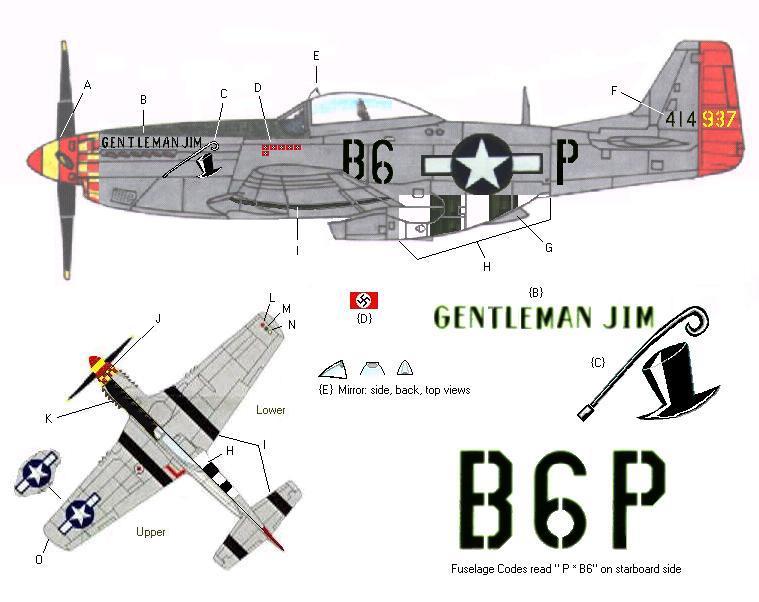357th FG Profile

Captain Jim Browning’s P-51D Mustang “Gentleman Jim”

Important Update!! – This profile is in error for the WWII Gentleman Jim. There were no black stripes on the wing and horizontal tail as shown here. These are on the restored P-51D “Gentleman Jim” that is flying today. They were put on for looks!
Winter 1944/45
Modeler Tips:
Side View Notes:
A. Rear red band on propeller boss extends onto spinner to leading edge of blades when in neutral pitch. Determine width of yellow band by dividing remainder of spinner evenly.
B. Glare shield is flat dark olive green and tapers away from upper cowl seam toward center of aircraft from forward bulkhead to propeller boss. “Gentleman Jim” rests above exhaust cutout with “Gentleman” the same length as the cutout.
C. Top Hat & Cane Nose Art. Note close proximity of cane to “m” in the word “Jim”.
D. Victory Board. 7 Nazi flags, 6 in top row. Upper edge of top row rests against panel seam. Outer edge of last column lines up directly beneath lowest point of windscreen side glass.
E. Clear perspex quarter dome with oval mirror place inside apex. Not standard equipment, can be made from scratch using Squadron Brand “Heat & Smash” Canopy Film. I used sandpaper to even up the shape of the front corner of an extra Spitfire Mk V “clipped wingtip” from my surplus parts as a smash mold. Refer to photo of P-51D on Modeler’s Guide front page.
F. Tail Number- black “414” on fin, yellow “937” on rudder.
G. Radiator ventilation flap is natural aluminum.
H. Reduced invasion stripes come up to lower edge of star & bar insignia. Full width, from aft fuselage bulkhead onto wing root at point of lowest dip in the wing fillet.
I. Black recognition stripes were of standard widths on wings & stabilizers for mid-1944 ETO Mustangs.
Upper & Lower View Notes:
I. Repeat of item “l” from Side View Notes.
J. Width of checkers reduced on underside in order to fit evenly on the narrow surfaces of the chin scoop area.
K. Repeat of item “B” from Side View Notes.
L, M, N. Red, Green, Yellow navigation lights- circular and flush with wing panel.
O. Formation Lights- Red (Port) and Green (Starboard)
Overall Modeling Tips:
*Paint on the flat colors first (recognition stripes, red rudder, glare shield) first- then mask off those features and paint the remainder of the aircraft in natural aluminum color. Most metal colors will be marred or removed by masking materials and should therefore be applied last.
*There were no antenna wires installed on this aircraft.
*After building several 357th A/C over the past 30 years, I recommend painting the nose area forward of the exhaust cutout yellow when the flat features are painted. Then when decal time comes, carefully cut away the yellow squares from the checkerboard decal and apply the remaining strip of red checkers to the nose. This method significantly reduces the potential for bubbles, and wrinkles plus it makes exact alignment of the decal easier.
*Prior to assembly, wash clear plastic parts with a mild glass cleaner and gently wipe dry. Then use a Q-Tip to evenly spread clear liquid floor wax (Future Brand seems to get the best results) on both inside & outside. Protect from dust and let dry for at least 2 hours. The wax fills in microscopic flaws and creates an even gloss that is clearer & shines brighter than the original plastic underneath.
SuperScale Decal Sheet 48-692

